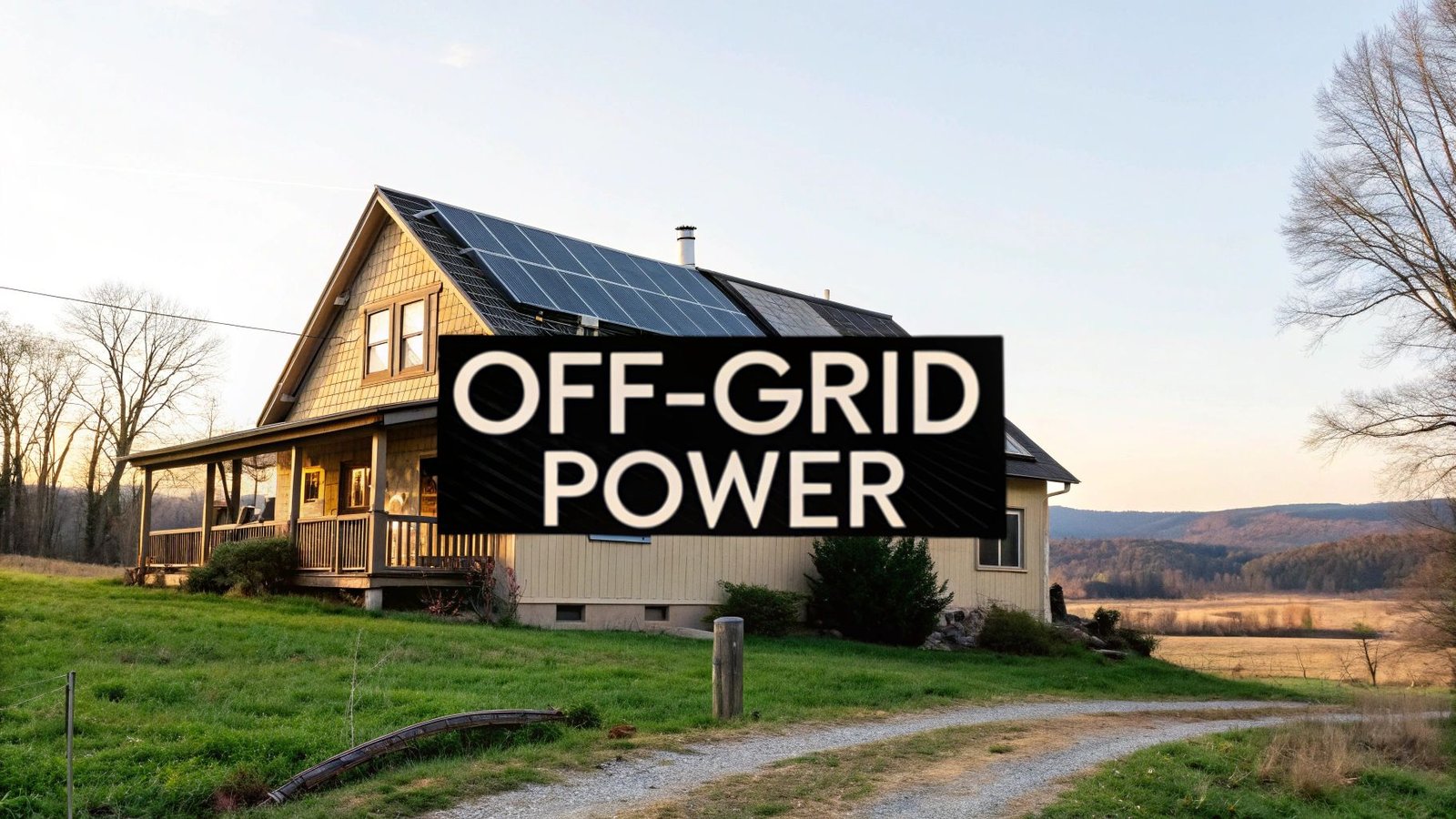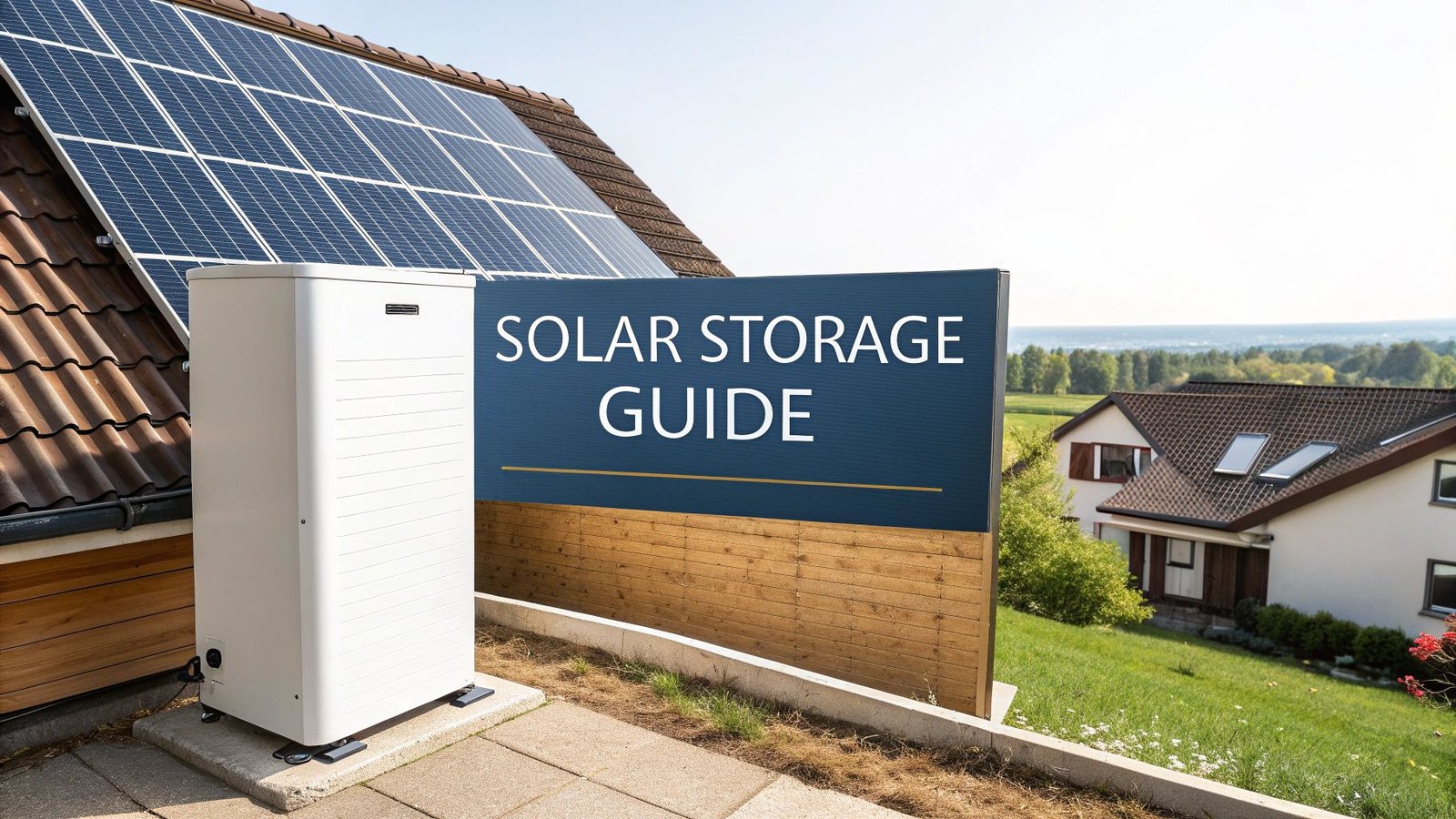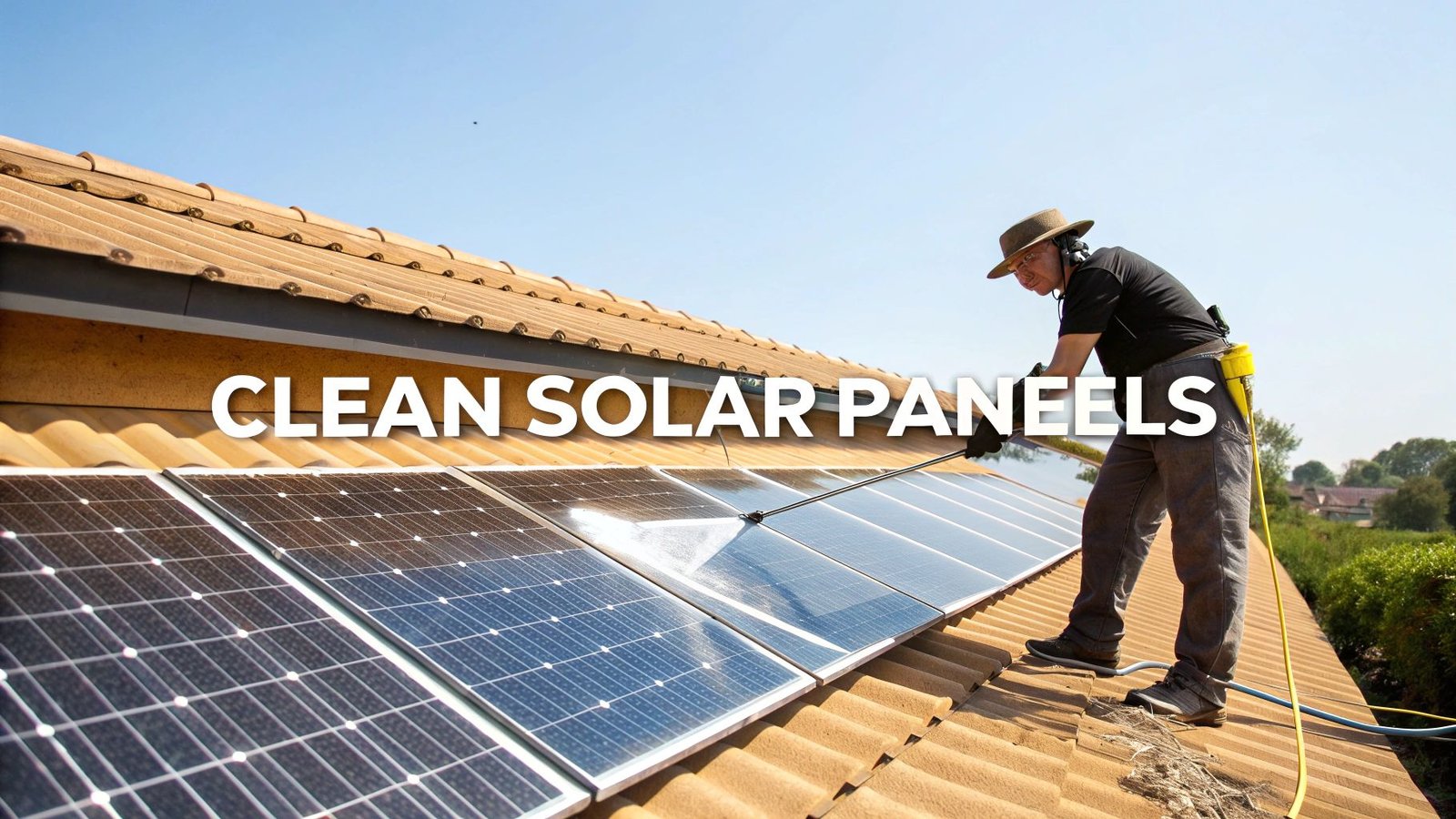Thinking about taking your home completely off-grid with solar? It's a huge step, and frankly, it's about much more than just swapping out your power source. This is a deliberate move toward a self-sufficient lifestyle. You're not just installing equipment; you're essentially becoming your own personal utility company. It means freedom from bills and blackouts, but it also means you're in charge of every watt you use.
Is Off-Grid Solar the Right Choice for Your Home?
Going off-grid is a serious commitment, one that comes with incredible perks and some very real responsibilities. The biggest draw, of course, is total energy independence. You're generating, storing, and using your own power, which means you can laugh in the face of grid failures and unpredictable rate hikes. This is a game-changer, especially if you live somewhere remote where the grid is flaky or doesn't even exist.
The trend toward home solar is undeniable. As of early 2025, over 4.7 million homes in the U.S. had made the switch to solar. While that’s still under 10% of all homes, it shows a massive shift toward energy resilience. Off-grid systems are a vital part of that movement. For a deeper dive into these numbers, SEIA's market insight report offers a comprehensive look.
The Lifestyle Shift to Off-Grid Living
Here’s the thing, though: that independence requires a whole new mindset. You are the power plant manager. This isn't a "set it and forget it" situation. You'll find yourself checking the weather forecast and your battery levels, especially during a long stretch of gray, cloudy days. Unlimited power is a thing of the past; now, you live within the means of what you can produce and store.
An off-grid lifestyle forces you to be mindful of every single watt. You stop being a passive consumer and become an active steward of your own energy. It's a demanding shift, but it can also be in credibly rewarding.
Before you even think about buying a single panel, the most critical step is a thorough power audit. I can't stress this enough. You need to walk through your home and list every single appliance, from your refrigerator to your phone charger, and figure out how much electricity it uses daily. This isn't just a suggestion—it's the only way to design a system that actually meets your needs without wasting thousands on oversized components.
Off-Grid Solar: A Quick Comparison
To put it all into perspective, let's look at the pros and cons side-by-side. This isn't a one-size-fits-all solution. What’s perfect for a weekend cabin in the woods might be a total headache for a family in a year-round home.
| Benefit | Consideration |
|---|---|
| Total Energy Independence | Higher Upfront Investment |
| No Monthly Electricity Bills | Requires Active Energy Management |
| Immunity to Grid Outages | Battery Maintenance and Replacement |
| Reduced Carbon Footprint | System Sizing Must Be Precise |
| Ideal for Remote Locations | Backup Generator Often Needed |
Ultimately, choosing off-grid solar power for homes boils down to what you value most. If resilience, sustainability, and having complete control over your power source are your top priorities—and you’re ready for the hands-on commitment it requires—then it can be an incredibly empowering journey.
Nailing Down Your Home's Real Energy Needs
The absolute first thing you have to do when planning an off grid solar power system is a power audit. I can't stress this enough—it's not just a suggestion, it's the bedrock of your entire project. If you get this part wrong, you'll either sink a ton of extra money into a system that’s way too big or, even worse, live with constant power shortages from a system that can’t keep up.
Forget about guesswork. To do this right, you need to become an energy detective in your own home. The mission is simple: calculate your total daily energy use in watt-hours (Wh). This number is what will dictate the size of your solar panels, battery bank, and inverter.
How to Conduct a Power Audit
Grab a notepad or open a spreadsheet and start listing every single thing in your house that plugs into a wall. Go room by room and be thorough. Don't just list the big stuff like the fridge and washing machine; get the little things, too—phone chargers, the Wi-Fi router, all of it.
For each item on your list, you need two pieces of information:
- Wattage (W): This is how much power the device uses when it's on. You can usually find this on a small sticker or plate on the appliance itself or buried in the user manual.
- Daily Run Time (Hours): This requires some honest estimation. How many hours a day does each device actually run? Your coffee maker might only be on for 15 minutes, but your refrigerator compressor likely kicks on and off for a total of about 8 hours over a 24-hour period.
Once you have those two numbers, the math is simple: Wattage (W) × Daily Run Time (Hours) = Daily Watt-Hours (Wh). Do this for every single item on your list.
Watch Out for Phantom Loads
A common mistake is forgetting about "phantom loads," sometimes called vampire power. These are devices that suck power 24/7, even when they’re turned "off." Think about your TV, the clock on your microwave, or computer monitors in standby mode.
These sneaky power draws can easily account for 5-10% of your total energy consumption. For an off-grid system, that’s a huge deal. The best way to find them is with a simple plug-in power meter, which will tell you exactly what these hidden energy hogs are costing you.
Mastering your home's energy consumption isn't just about counting watts; it's about shifting your mindset from passive energy user to active energy manager. This audit is your first real test.
This infographic gives you a bird's-eye view of the entire project, from the assessment we're doing now all the way to flipping the switch.
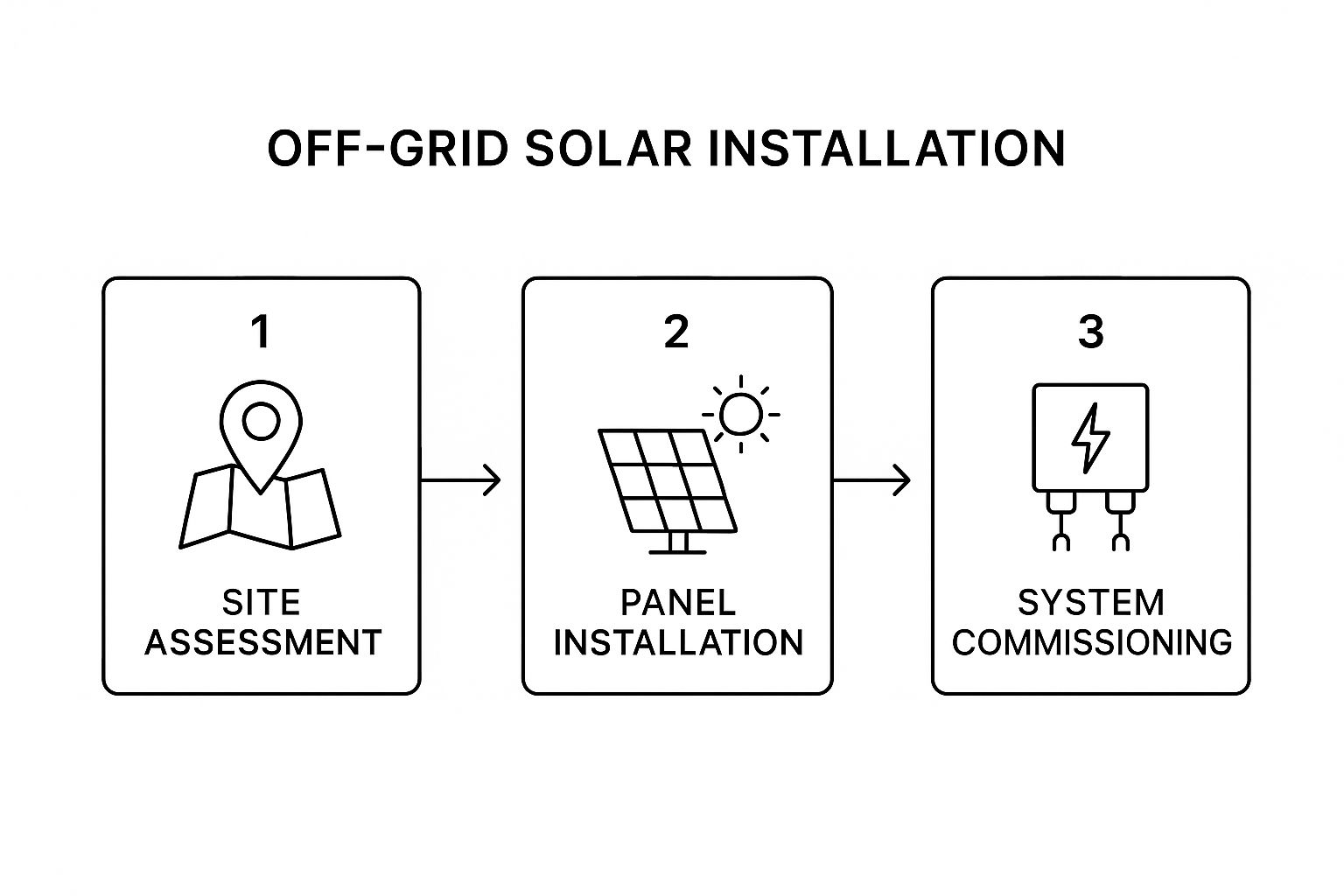
As you can see, a successful project moves in a logical sequence, and it all starts with the critical planning and assessment phase we're covering right now.
Un ejemplo real: Ponerlo todo junto
Let's see what this looks like in practice. The chart below shows a simplified audit for a small family home. Your final list will be much longer, but this shows how the numbers come together to give you that crucial final target.
Appliance | Daily Energy (Wh)
------------------|--------------------
Refrigerator | 1200
LED Lights (10) | 500
Laptop & Monitor | 480
Television (55") | 450
Well Pump | 375
------------------|--------------------
TOTAL | 3005 Wh (3.0 kWh)
After adding everything up, this family’s daily energy need is roughly 3,005 Wh, which is 3.0 kWh. This is the most important number you'll generate during your planning. It tells you exactly how much power your panels need to produce—and your batteries need to store—every single day to keep your home running smoothly.
Elegir los componentes adecuados del sistema
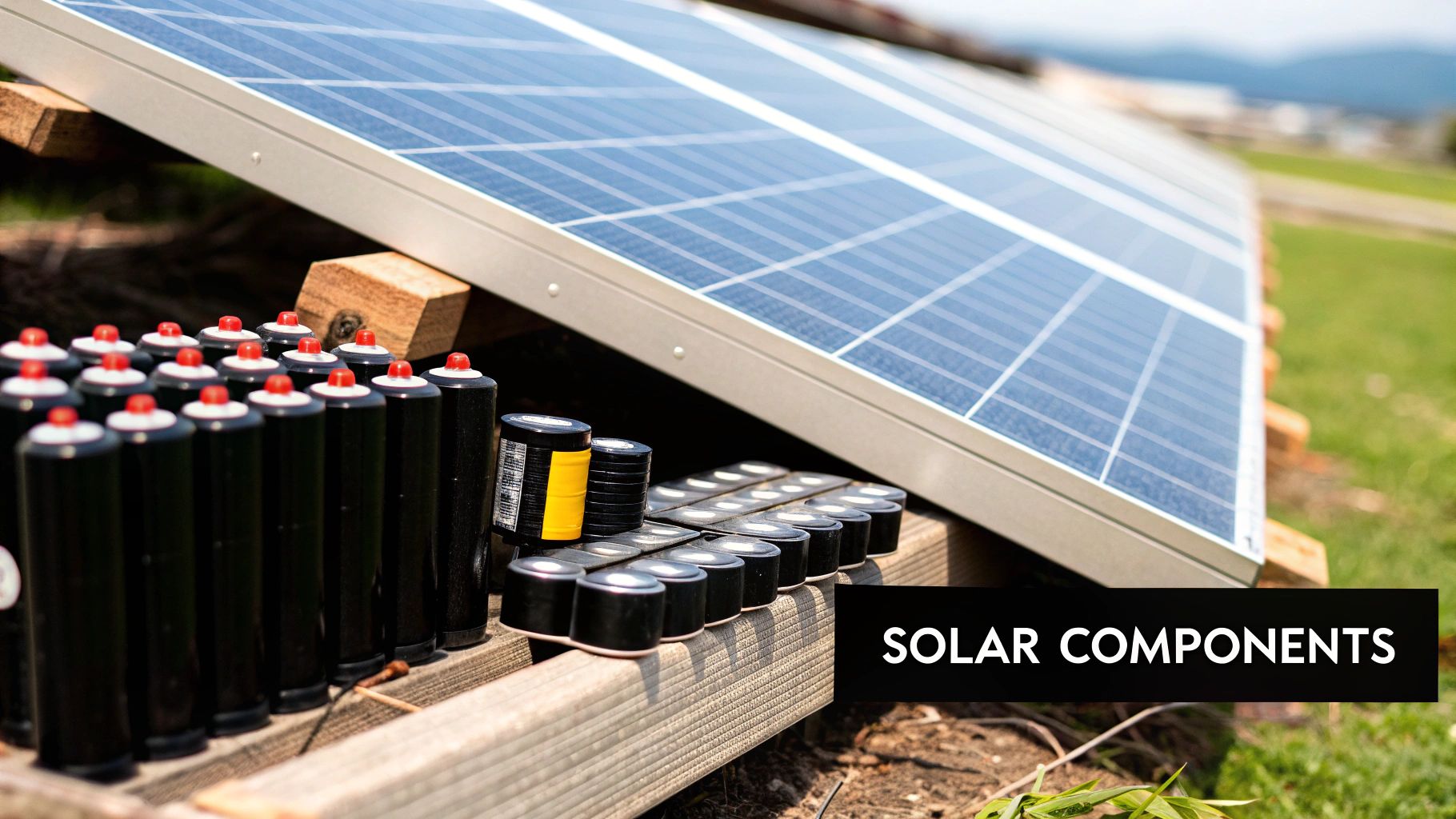
Alright, you've done the math and know how much power you need. Now for the exciting part—picking the hardware that will become your personal power plant. Think of an off grid solar power for homes setup less like a kit and more like a team of specialists working in concert. Every single component has a critical role, and getting the selection right is what separates a reliable, long-lasting system from a frustrating money pit.
This isn't just about buying parts off a shelf. It's about making smart, informed decisions that align with your budget, your performance goals, and your day-to-day life.
The momentum behind solar is undeniable. As a reference point, the UK alone had installed roughly 19 gigawatts (GW) of solar capacity by mid-2025. This surge, driven by unpredictable electricity prices and a desire for sustainability, resulted in over 1.5 million UK homes installing solar panels. It's a clear trend toward energy independence, and off-grid systems are a huge part of that story. You can explore the full solar energy statistics on Sunsave.energy to see the data for yourself.
Solar Panels: The Engine of Your System
Your solar panels are the engine room, responsible for capturing sunlight and converting it into direct current (DC) electricity. You'll primarily be choosing between two technologies: monocrystalline and polycrystalline.
- Monocrystalline Panels: These are the sleek, high-performance option, made from a single, pure silicon crystal. You can spot them by their uniform black color. They boast the highest efficiency, typically between 18-22%, which means they produce more power in a smaller footprint. They are the go-to choice for anyone with limited roof space.
- Polycrystalline Panels: Made from multiple silicon fragments melted together, these panels have a distinctive blue, marbled look. Their efficiency is a bit lower, around 15-17%, but they usually come with a friendlier price tag. If you have plenty of unshaded space, they can be a very practical, budget-conscious choice.
Panel Type | Efficiency | Appearance | Best For
------------------|------------|---------------|-----------------------
Monocrystalline | 18-22% | Uniform Black | Limited Space
Polycrystalline | 15-17% | Blue, Marbled | Large Areas, Budget
While polys might save you some cash upfront, the superior efficiency of mono panels often delivers better value over the long haul. This is especially true in areas with less-than-perfect sunshine, where you need to squeeze every last watt out of the available light.
The Charge Controller: The Traffic Cop
The charge controller is the unsung hero of your off-grid system. It's the diligent traffic cop standing between your solar panels and your battery bank, managing the flow of power. Its most important job is to prevent overcharging, which can quickly destroy your expensive batteries and cut their lifespan short.
You'll encounter two main types: PWM (Pulse Width Modulation) and MPPT (Maximum Power Point Tracking). For virtually any modern off grid solar power for homes system, an MPPT charge controller is the only one you should seriously consider.
Yes, they cost more than their PWM counterparts. But an MPPT controller can boost your energy harvest by as much as 30%, particularly in cold weather or on overcast days. It actively scans for the optimal voltage and current from your panels to push the maximum amount of energy into your batteries. Over time, it easily pays for itself through those efficiency gains.
This is not the place to cut corners. A quality MPPT controller is a non-negotiable investment. It protects your battery bank—the most expensive component of your system—and makes sure you’re not wasting the precious power your panels generate.
The Battery Bank: Your Personal Energy Reservoir
This is where your energy freedom really begins. Your battery bank stores the electricity your panels produce during sunny days, holding it for you to use at night, on cloudy mornings, or whenever you need it. Here, you face the biggest decision of the whole project: the classic showdown between lead-acid and lithium-ion.
This isn't just about the initial price tag; it's a decision based on lifecycle cost, real-world performance, and the amount of maintenance you're willing to do.
To make an informed choice, you need to understand the fundamental trade-offs between the two main deep-cycle battery technologies.
Deep-Cycle Battery Technology Comparison
| Característica | Flooded Lead-Acid (FLA) | Lithium-Ion (LiFePO4) |
|---|---|---|
| Coste inicial | Bajo | Alta |
| Lifespan | 5-7 years | 10-15+ years |
| Maintenance | High (Requires regular watering & equalization) | Virtually None |
| Profundidad de descarga (DoD) | 50% (Only use half the capacity) | 80-95% (Use almost all the capacity) |
| Eficacia | ~80-85% | ~95% or higher |
| Lifecycle Cost | Moderate to High (due to replacements) | Low to Moderate |
Flooded lead-acid (FLA) batteries were the industry workhorse for decades, mainly because they were cheap to buy. The catch? They require a lot of hands-on maintenance and have a very limited Profundidad de descarga (DoD) of just 50%. That means if you buy a 400 Ah battery bank, you really only have 200 Ah of power you can actually use without damaging the cells.
On the other hand, lithium-iron-phosphate (LiFePO4) batteries—a very safe and stable type of lithium-ion—are the modern standard. They have a much deeper DoD (often 80% or more), last at least twice as long, and are completely maintenance-free. While the check you write upfront is bigger, their superior performance and longevity mean you often spend far less over the life of your system because you aren't buying replacements every few years.
The Inverter: Translating Power for Your Home
Finally, the inverter acts as the system's translator. It takes the low-voltage DC power stored in your batteries and converts it into the standard AC power your home's appliances run on. If you plan on using any modern electronics—from laptops and TVs to kitchen gadgets—a pure sine wave inverter is non-negotiable.
Cheaper, modified sine wave inverters produce a choppy, blocky electrical signal that can wreak havoc on sensitive electronics, causing them to buzz, overheat, or fail completely. A pure sine wave inverter, however, produces clean, stable electricity that is often better quality than the power from the utility grid. It ensures everything in your home runs smoothly and safely.
Sizing is also crucial. Your inverter must have enough capacity to handle the combined wattage of all the appliances you might want to run at the same time.
Installation and Permitting: Bringing Your System to Life

You’ve done the math and picked your gear. Now for the exciting part: turning those plans and components into a working off grid solar power for homes system. This is where your blueprints meet the real world, and it’s a phase that absolutely must be guided by safety and a healthy respect for local regulations.
Think of installation as more than just bolting down panels and connecting wires. You're building a personal power plant, and you want it to be safe, reliable, and durable enough to last for decades. This means careful work, from placing your array to the final electrical hookups, and it means working with your local authorities, not around them.
Where Should You Build Your Array?
The first big question is where your panels will live. You've got two main options: on the roof or on the ground. Each has its pros and cons, and the right choice depends entirely on your property.
- Roof-Mounted Systems: If you have a solid, south-facing roof with plenty of sunshine, this is often the go-to choice. It’s space-efficient because you’re using a structure that’s already there. But first, you have to be certain your roof can handle the load. Get a professional opinion on its structural integrity, as the combined weight of panels and racking, especially with snow, is significant.
- Sistemas instalados en el suelo: Is your roof shaded by trees, facing the wrong direction, or just not built for the extra weight? A ground-mounted system is an excellent alternative. It gives you the freedom to position your panels at the absolute perfect tilt and orientation for maximum solar gain. While it takes up yard space, it also makes tasks like cleaning snow off the panels a whole lot easier.
From my experience, a well-placed ground-mounted array can often produce 5-10% more power than a similar-sized roof system. That extra efficiency really adds up when you’re living off the grid.
Don't Skip the Permits: Working with Your AHJ
Before you even think about digging a post hole or drilling a pilot hole, you need to talk to your Authority Having Jurisdiction (AHJ). This is just the official term for your local city or county building department—the folks who ensure things are built safely and to code.
Trying to fly under the radar is a terrible idea. It can lead to massive fines, orders to tear down your work, and, worst of all, an unsafe system.
Make your AHJ your first call. They'll lay out exactly what's required, which usually includes building permits for the physical structure and electrical permits for the wiring. They will almost certainly ask for an electrical one-line diagram.
Your one-line diagram is the roadmap of your entire system. It’s a clean, simple drawing showing every major component—panels, charge controller, inverter, batteries, and safety disconnects—and how they connect. A professional diagram isn't just a good idea; it's a non-negotiable requirement for getting a permit.
Installation Safety and Knowing When to Call a Pro
The actual install is a methodical process. Once the racking and panels are securely mounted, you'll install the brains of the operation—the inverter, charge controller, and batteries—typically in a protected area like a garage or shed. Wiring these components together requires precision and a solid grasp of electrical safety.
One of the most critical safety elements is proper system grounding. This is what protects both you and your expensive equipment from power surges and lightning. It's a complex task and one of the best reasons to bring in a professional.
While a skilled DIYer can handle much of the physical installation, I always recommend hiring a licensed electrician for the final connections and tie-in. Their expertise ensures everything meets the latest National Electrical Code (NEC) standards, which is exactly what the inspector from your AHJ will be looking for.
A few hundred dollars for an electrician’s time is a small price for the confidence that your system is safe, compliant, and ready to power your life for years to come. It’s the final, crucial step on your path to true energy independence.
Long-Term System Maintenance and Care
https://www.youtube.com/embed/II9X6rnwg6I
You've invested a lot of time and money into your off grid solar power for homes system. Now, let's talk about keeping it running smoothly for the long haul. Think of it like owning a car—a little routine care goes a long way in preventing major headaches down the road and protecting your energy independence.
The good news is that solar systems are remarkably low-maintenance. A few simple, consistent checks are usually all it takes to catch small issues before they snowball into costly repairs. This isn't about adding a bunch of chores to your list; it's about making sure your personal power plant operates at its best for decades to come.
Creating a Seasonal Maintenance Rhythm
The easiest way to stay on top of maintenance is to build it into your seasonal routine. Your system's environment changes with the seasons, and so do the things you need to keep an eye on.
A big one is keeping your solar panels clean. Throughout the year, they’ll get covered in a film of dust, pollen, bird droppings, and general grime. This isn't just a cosmetic issue. Dirty panels can lose up to 20% of their output, which is a significant chunk of power that never even makes it to your batteries.
Here’s a practical checklist to work from:
- Twice-a-Year Cleaning: Plan on giving your panels a gentle wash in the spring and fall. All you need is a soft brush and clean water. Stay away from harsh soaps or abrasive scrubbers that can scratch the anti-reflective coating.
- Winter Watch: If you get snow, you'll need a plan to clear it off the panels safely. A long-handled, soft-bristled snow rake is the perfect tool for the job. Never use a metal shovel.
- Quick Visuals: Every time you're up there, take a quick look around. Check for any cracked glass on the panels or obviously loose wiring and mounting hardware.
A clean solar panel is a productive solar panel. I always tell my clients to treat panel cleaning just like washing their windows. It's one of the simplest things you can do to get every possible watt out of your investment.
Battery Health and System Monitoring
Your battery bank is the heart of your off-grid system, so keeping it healthy is critical. The specific care depends entirely on your battery chemistry. Older-style flooded lead-acid batteries, for instance, need you to periodically top off the water levels and run an "equalization charge" to keep the cells balanced and prevent sulfation. Always follow the manufacturer’s specific schedule for this.
If you've gone with modern lithium-ion (LiFePO4) batteries, you're in luck—they are almost entirely maintenance-free. But "no maintenance" doesn't mean "no monitoring." For any battery type, your system monitor or Battery Management System (BMS) is your most important tool. It’s your real-time dashboard, showing you the battery's state of charge, how much power you're producing, and what you're using.
The push for this kind of energy independence is happening worldwide. In fact, by the end of 2024, the total global solar capacity shot past 2,2 teravatios (TW), a massive leap from 1.6 TW just a year before. This explosive growth shows how important reliable, well-maintained systems are becoming for people everywhere. You can read more about these global PV market trends to see the bigger picture.
Simple Troubleshooting for Common Issues
Even with the best care, you’ll probably run into a hiccup now and then. But don't panic if your power suddenly dips—it's often a simple fix. Before you call for help, run through these common scenarios.
| Symptom | Possible Cause | What to Check First |
|---|---|---|
| No Power to Appliances | A breaker tripped or a fuse blew. | Check your main AC and DC breaker boxes. Reset any tripped breakers. |
| Low Battery Warning | Several cloudy days in a row or you've used more power than usual. | Look at your energy usage. Can you cut back on non-essential loads for a bit? |
| System Not Charging | A wire came loose, or the panels are just really dirty. | Do a visual check of all accessible wiring. Give the panels a good cleaning. |
| Inverter Fault Light On | The system was overloaded, or there's an internal error. | Try a simple reboot: turn the inverter off for a minute, then back on. Check the manual for the specific fault code. |
By working through problems methodically, you can often solve the issue yourself in minutes. Staying on top of these simple checks and maintenance tasks will ensure your off-grid solar system remains a reliable and powerful asset for years to come.
Frequently Asked Questions

As you start seriously thinking about an off grid solar power for homes setup, it's only natural to have a lot of questions. This isn't just a small project; it's a major investment and a fundamental shift in how you manage your energy. We've been there.
Below, I've answered some of the most common—and important—questions that come up when people are planning their move to full energy independence.
How Many Panels and Batteries Do I Really Need?
This is, without a doubt, the question I hear most. The only honest answer is: it depends entirely on you. The size of your system comes down to two key things: your daily energy consumption (in kWh) and the average peak sun hours you get at your specific location.
There's no magic number. You have to do the detailed power audit we walked through earlier to get an accurate figure. Guessing is the quickest way to end up with a system that either can't keep up with your needs or costs you thousands in equipment you didn't need. For a very rough ballpark, a small, efficient off-grid home might land somewhere in the 3kW to 5kW solar array range with a 10kWh to 20kWh battery bank.
A personalized power audit isn't an optional step. It's the single most important calculation in designing an off-grid system that actually works. Think of it as the foundational blueprint for your energy future.
To give you a clearer sense of the scale and potential costs, here’s a sample breakdown for different scenarios. Keep in mind, these are just estimates. Your final costs will depend on the quality of components you choose, your location, and labor rates.
Estimated Off-Grid System Costs
| Home Size / Usage Profile | Est. Solar Array Size | Est. Battery Bank Size | Estimated Cost Range |
|---|---|---|---|
| Small Cabin (Weekend Use) | 1kW – 3kW | 5kWh – 10kWh | $8,000 – $15,000 |
| Small Home (Efficient) | 3kW – 5kW | 10kWh – 20kWh | $20,000 – $35,000 |
| Average Family Home | 5kW – 8kW | 20kWh – 30kWh | $35,000 – $50,000+ |
| Large Home (High Demand) | 8kW+ | 30kWh+ | $50,000 – $70,000+ |
This table shows just how quickly the equipment needs and the budget grow with your energy demands.
Should I Get a Backup Generator?
Yes. Absolutely. I consider it essential. While a perfectly designed system will handle your needs almost all the time, a backup generator is your ultimate safety net for true energy security. It’s cheap insurance.
A generator—whether it runs on propane, diesel, or gas—is what gets you through those long stretches of bad weather. Think about extended cloudy periods, heavy snow cover on your panels, or a week of back-to-back storms. In those situations, your solar panels simply can't fully recharge your batteries. The generator fires up to top off the battery bank, which prevents a deep discharge that could permanently damage your expensive batteries and leave you in the dark.
What Is the Real Total Cost for an Off-Grid System?
The true cost of an off grid solar power for homes system is a wide spectrum. As you can see from the chart, a small DIY setup for a part-time cabin might run you $8,000 to $15,000. At the other end, a professionally installed system for a modern family home can easily go from $35,000 to over $70,000.
Your two biggest budget items will almost always be:
- The Battery Bank: This is especially true if you choose high-performance, long-lasting lithium (LiFePO4) batteries. They are the most expensive single component, but they offer the best value over the long haul.
- Professional Labor: While it adds to the upfront cost, hiring licensed installers and electricians is the only way to guarantee your system is safe, up to code, and performing the way it should.
The initial investment is significant, there's no denying it. But remember, it effectively erases your monthly electricity bill for decades, providing a powerful return over the life of the system.
Are There Tax Credits for Off-Grid Solar?
Yes, in many cases, there are financial incentives that can bring down the net cost of your system quite a bit. In the United States, the Federal Solar Tax Credit (also called the Investment Tax Credit or ITC) has been a huge help for homeowners.
This credit typically applies to the entire cost of off grid solar power for homes systems, including the panels, inverter, racking, and even the batteries, as long as they are charged by solar. It's generally available for systems installed at a primary or secondary residence.
However, tax laws and incentive programs change. State and local incentives also vary widely. It is absolutely critical to consult with a qualified tax professional and check for the latest information from official sources like the IRS and your state's energy office to confirm your eligibility and get the current rules.
Ready to take the first step toward energy independence with a professionally designed and installed system? The experts at Energía radiante can guide you through every stage, from a precise power audit to seamless installation and long-term support. Discover our high-quality solar solutions and start your journey today at https://radiantenergysolar.com.

